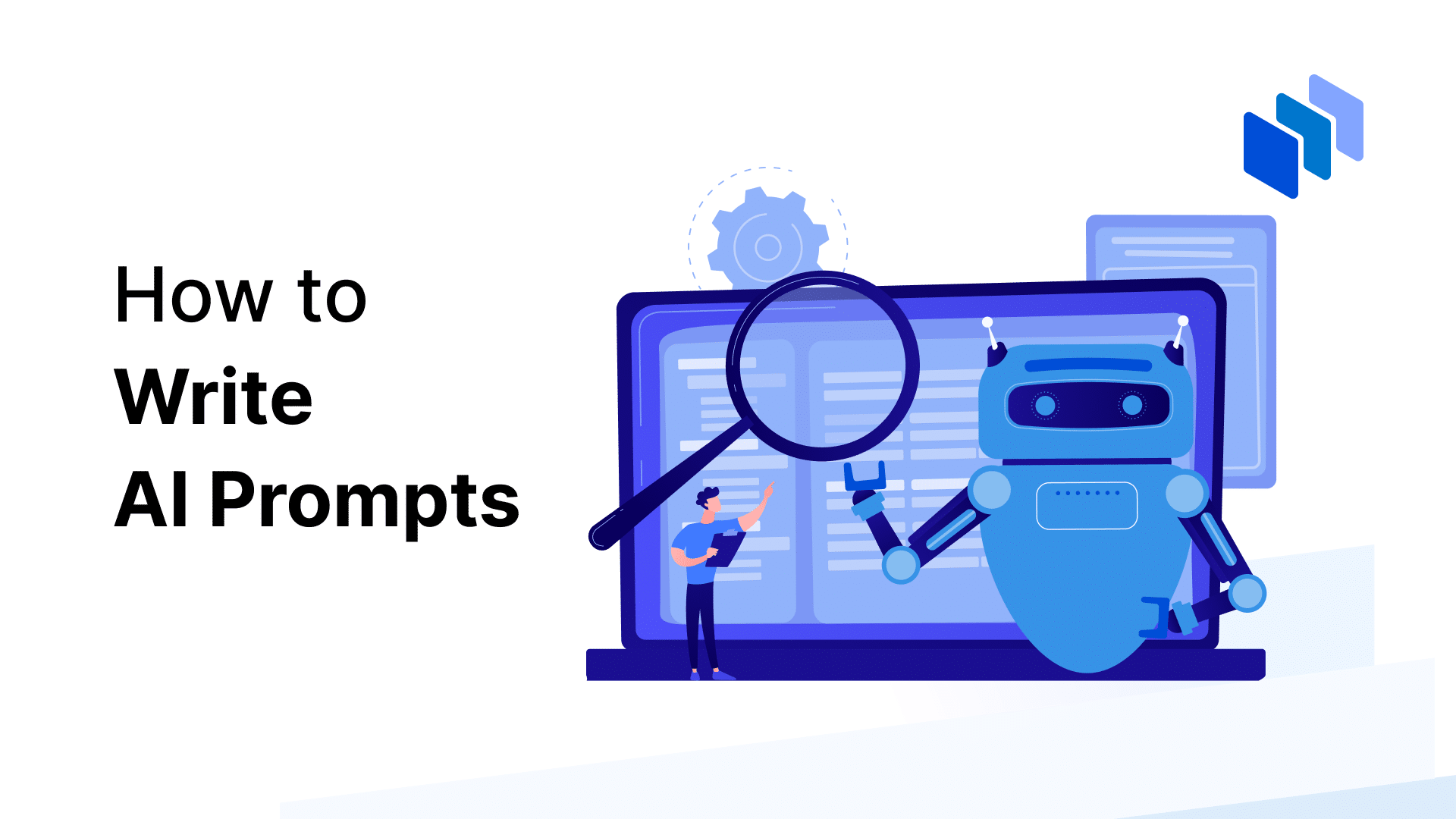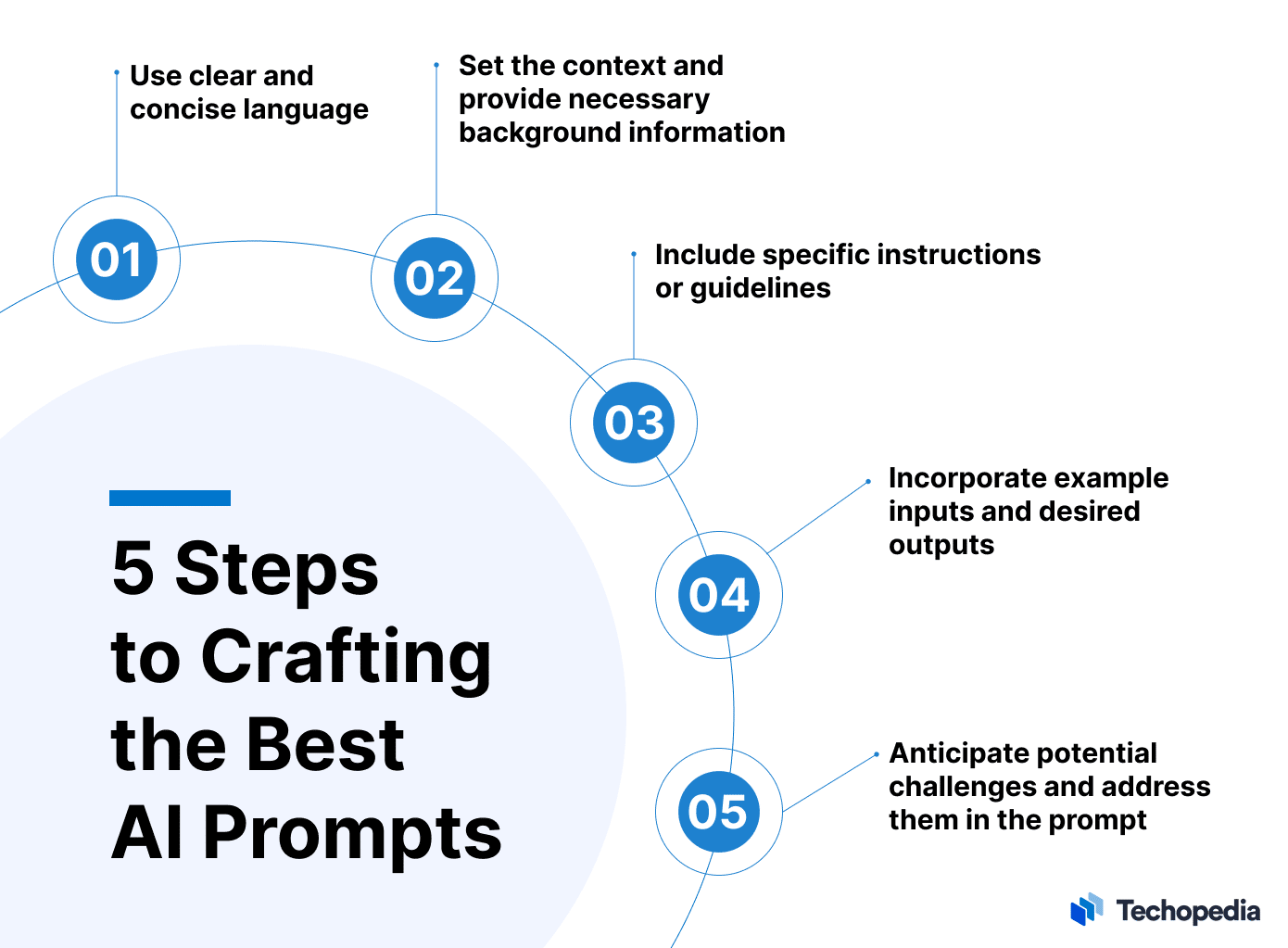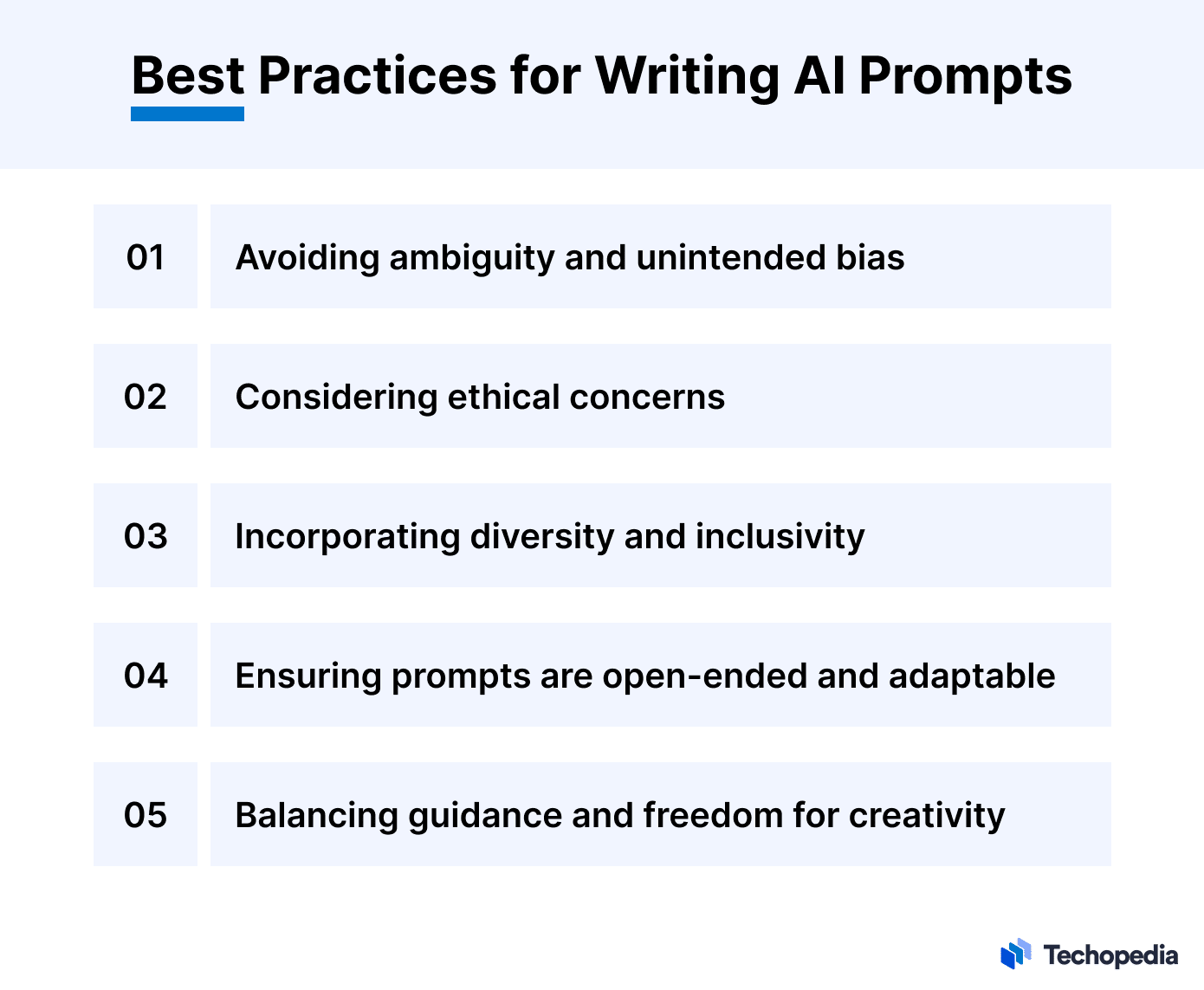Writing well-crafted prompts is a fundamental part of working with artificial intelligence (AI) models, as they serve as the means for generating relevant and accurate responses.
In this guide, we will explore the importance of effective prompt engineering and provide you with the necessary tools and techniques to write good prompts for AI that result in the desired outputs.
What is an AI Prompt?
At a basic level, an AI prompt is a set of instructions or input provided to an AI model to generate a response. Prompt engineering involves carefully designing and refining these instructions to produce the desired output.
It consists of experimenting with different phrasings, context, and conditioning techniques to improve the accuracy and relevance of the generated responses.
Different Types of AI Prompts
There are various types of AI prompts, each serving different purposes and requiring specific approaches.
Here are some of the most common prompts, along with examples related to prompt engineering:
| Prompt Type | Description | Prompt Example |
| Completion Prompts | Involve providing an incomplete sentence and asking the AI model to generate a coherent continuation. | “Complete this sentence: Prompt engineering is…” |
| Question Prompts | Assume asking a specific question prompting the AI model to generate a related response. | “What are the key principles and techniques used in prompt engineering to optimize the output of AI models?” |
| Instruction Prompts | Imply providing explicit instructions for the AI model to follow, specifying the desired outcome. | “Write a step-by-step guide on effectively employing prompt engineering strategies when working with AI models.” |
| Comparison Prompts | Make the AI model compare different elements, generating insights based on the provided criteria. | “Compare the effectiveness of prompt engineering in enhancing the performance of AI models versus using unstructured prompts.” |
| Creative Prompts | Encourage the AI model to generate innovative ideas, stories, or artistic outputs. | “Imagine a future where prompt engineering has advanced to its full potential. Write a short story describing how prompt engineering revolutionized the field of AI and other industries.” |
| Translation Prompts | Involve providing text in one language and instructing the AI model to translate it into another. | “Translate the term ‘prompt engineering’ into French.” |
| Summarization Prompts | Ask the AI model to condense a given text or information into a concise summary. | “Summarize the benefits and challenges associated with prompt engineering in three concise points.” |
| Dialogue Prompts | Instruct the AI model to generate responses from different perspectives or characters. | “Generate a conversation between two AI researchers discussing the significance of prompt engineering in improving the reliability and interpretability of AI models.” |
Preparing to Write AI Prompts
You can follow these preparatory steps to maximize the effectiveness of AI prompts.
- Define the Target Audience and Purpose
Understanding who will use the AI-generated content and its purpose will inform optimal prompt design. You can also specify a style in which the AI model, such as ChatGPT, should write. If you do, ensure you’re legally authorized to use someone’s style to avoid copyright and other legal issues.
- Research the Topic
Gain a deep understanding of the subject matter to create prompts that generate accurate and relevant responses (or edit possibly incorrect information should the AI model provide any).
- Understand AI Model’s Capabilities
Learn the strengths and weaknesses of the AI model to get the most out of them and what to expect in terms of output.
How to Write a Good AI Prompt
When designing AI prompts, it is crucial to remember the following guidelines.
- Use Clear and Concise Language
Create prompts using clear and concise language to ensure the AI model understands the task or request accurately and avoids any confusion. Avoid spelling mistakes and use correct punctuation.
- Set the Context and Background Information
Provide the necessary context and background information in your prompts to help the AI model understand the subject matter and generate more contextually relevant responses.
Consider that some AI models don’t have live access to the internet, so if you are writing about something very new, it may be necessary to provide novel information in your prompt to allow for an updated and relevant response.
- Provide Specific Instructions and Guidelines
Include specific instructions and guidelines in your prompts to direct the AI model toward generating outputs that align with your desired requirements or objectives.
Here is a practical example of this.
Explanation:
- In the “Without prompt engineering” example, the prompt lacks specific instructions, such as the function name and desired output format, making the task ambiguous for the AI model.
- In contrast, the “With prompt engineering” example provides clear instructions by specifying the function name “count_word_occurrences,” the input format (a string of text), and the desired output format (a dictionary with word counts).
These details help the AI model understand the task better and generate more accurate code.
- Incorporate Examples and Desired Outputs
Improve the clarity of your prompts by including examples of inputs and desired outputs, enabling the AI model to understand the expected response format and content better. Here’s a practical example.
Explanation:
The improved prompt clarifies the task and gives a specific illustration of the expected result by providing the desired input and output examples.
- Anticipate and Address Potential Challenges
Anticipate potential challenges or limitations the AI model might encounter and proactively address them in your prompts. For instance, avoid placing two questions in the same line, as the model could only answer one.
Tailoring Prompts for Specific AI Models
To maximize the potential of AI models, it is crucial to tailor prompts that align with their unique capabilities and optimize performance.
Here are a few elements to consider while operating different AI models.
- Understand AI Model Capabilities
Different AI models have additional capabilities. For instance, some can generate text, other images, and others still both. As mentioned above, some AI models can retrieve information from the internet, while others only have access to a database of pre-scanned information.
Understanding an AI model’s capabilities is vital to crafting successful prompts.
- Modify Prompts for Specific Tasks
Because different AI models excel in various tasks, it is necessary to modify prompts accordingly to suit the specific task requirements.
For example, for a language translation prompt, an effective way of formulating a request would include the input language, the desired output language, and a specific sentence to be translated.
- Adapt Prompts for Fine-Tuning or Transfer Learning
For fine-tuning or transfer learning processes, you can adapt prompts to suit the specific requirements of these techniques. The adaptation enables the AI model to learn and apply knowledge from related tasks or domains, enhancing the quality of its responses.
Testing and Iteration
Once you have successfully prompted the AI model to create content that is insightful, you can take a few steps to enhance the effectiveness of your AI prompts further.
- Test With Sample Prompts
Before feeding an AI model with hundreds of lines of text, you can test a set of sample prompts and evaluate the generated outputs to gather feedback and make necessary refinements. You can then apply those to a broader sample.
- Iterate and Refine Prompts
You can also incorporate user feedback and iterate on your prompts to improve their quality and performance continuously. Just make sure to rephrase user feedback to maximize the AI model’s performance, as explained above.
Best Practices for Writing AI Prompts
You can do several things to ensure the quality and ethical considerations of your AI prompts. Here are some of them.
- Avoiding Ambiguity and Unintended Bias
Use language that is clear, unambiguous, and free from biases to generate appropriate responses. You can also ask the model to remove unintended biases in its output. Just double-check the results, as they may not encompass all bias types.
- Considering Ethical Concerns
Be mindful of the potential impact of AI-generated content on your audience and ensure prompts align with your you or your company’s ethical standards.
- Incorporating Diversity and Inclusivity
Design prompts that consider diverse perspectives and promote inclusivity to avoid biased or one-sided responses. Tweak possibly biased responses to eliminate these biases.
- Ensuring Prompts are Open-Ended and Adaptable
Try to create prompts encouraging creativity while allowing the AI model to generate various responses rather than restricting it to a narrow set of possibilities.
- Balancing Guidance and Freedom for Creativity
On the other hand, you should provide sufficient guidance in prompt creation to ensure the results are within the realm of what you consider acceptable. Finding the right balance of guidance and creativity may require some trial and error.
Troubleshooting Common Issues
Despite all the best practices described above, you may still need help with AI prompts. Here are some of the most common ones and how to overcome them.
- Deal with Unhelpful or Off-Topic Responses
If this happens, analyze the prompts and modify them to provide more precise instructions or address any confusion that might lead to irrelevant responses.
- Address Prompt Failures or System Limitations
Not all prompts will yield the desired results, so you should explore alternative approaches or adjust expectations accordingly. Also, keep in mind that specific AI models have been limited not to discussing certain topics, and doing that may result in your account being flagged or banned.
- Techniques for Improving the Quality of Generated Outputs
You can experiment with different prompt variations, adjust parameters, or utilize post-processing techniques to improve the quality of AI-generated content.
Resources and Tools
To assist you in writing effective AI prompts, consider the following resources and tools.
Online Platforms and APIs
Several online platforms and APIs offer prompt generation capabilities. These platforms often provide user-friendly interfaces where you can input your requirements and receive generated prompts.
Some platforms also integrate advanced AI models, enabling you to explore different prompt styles and variations. These tools can save time and effort by automating the prompt generation process.
Here are some of the most commonly used platforms and APIs for generating AI prompts:
- The OpenAI Playground allows you to generate text using powerful language models.
- ChatGPT provides a user-friendly interface for direct interaction with the model.
- Hugging Face Transformers offers pre-trained language models through their Python library.
- IBM Watson’s Natural Language Understanding service and Google Cloud’s Natural Language API enable text analysis for generating AI prompts.
- Microsoft Azure, on the other hand, offers services like the Text Analytics API and Language Understanding (LUIS) to understand text and generate meaningful prompts.
Reference Materials and Case Studies
Reference materials and case studies are essential for writing effective AI engineering prompts. These informative tools provide insights and real-world examples that help shape the content and context of the prompts.
Reference materials, such as academic papers, technical documentation, and industry reports, offer a deep understanding of AI concepts, algorithms, and methodologies. They serve as a foundation for constructing prompt questions that challenge engineers to apply their knowledge and problem-solving skills.
Case studies, on the other hand, showcase practical implementations of AI in various domains, allowing prompt creators to design scenarios that reflect real-life challenges.








